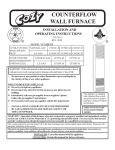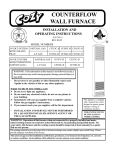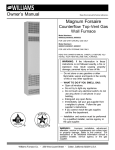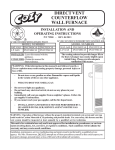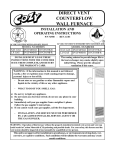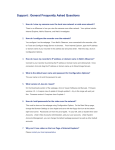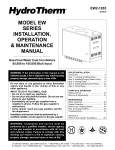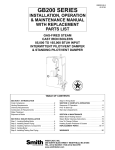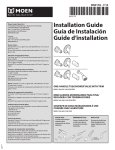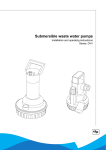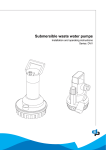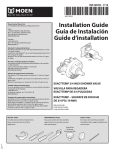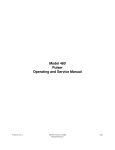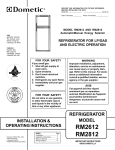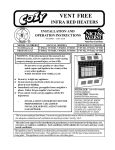Download Product Manual
Transcript
COUNTERFLOW WALL FURNACE INSTALLATION AND OPERATING INSTRUCTIONS P/N 78111 / REV. 06/2013 R R MODEL NUMBERS 24 VOLT SYSTEM WITH LOW-BTU PILOT 24 VOLT SYSTEM WITH INTERMITTENT IGNITION (I.I.D.) NATURAL GAS CF403D-H CF553D-H L.P. GAS CF404D-H CF554D-H NATURAL GAS CF407D-H CF557D-H L.P. GAS CF408D-H CF558D-H WARNING: If the information in this manual is not followed exactly, a fire or explosion may result causing property damage, personal injury or loss of life. - Do not store or use gasoline or other flammable vapors and liquids in the vicinity of this or any other appliance. WHAT TO DO IF YOU SMELL GAS: Do not try to light any appliance. Do not touch any electrical switch; do not use any phone in your building. Immediately call your gas supplier from a neighbor’s phone. Follow the gas supplier’s instructions. If you cannot reach your gas supplier, call the fire department. - INSTALLATION AND SERVICE MUST BE PERFORMED BY A QUALIFIED INSTALLER, SERVICE AGENCY OR THE GAS SUPPLIER. This appliance is equipped with a blocked flue switch designed to protect against improper venting of combustion products. THIS UNIT IS NOT TO BE INSTALLED IN MOBILE HOMES. WARNING: Operation of this furnace when not connected to a properly installed and maintained venting system can result in Carbon Monoxide (C.O.) poisoning and possible death. For your safety, this furnace and the venting system should be inspected at least annually by a qualified service technician. The coating selected to provide longer life to the heat exchanger may smoke slightly upon initial firing. Please provide adequate ventilation if this occurs. This unit is for residential use only and is not approved for installation in mobile homes, greenhouses, or environments involving dusty, wet, corrosive, or explosive conditions. Such conditions will invalidate the warranty and may create unsafe conditions. Installation, maintenance, service, troubleshooting and repairs must be performed by a qualified service agency. Mr./ Mrs. Homeowner, DO NOT attempt any of these procedures yourself as this could expose you to property damage, personal injury or loss of life and will invalidate all warranties. INSTALLER: Leave this manual with the appliance. CONSUMER: Retain this manual for future reference. The State of Massachusetts requires that installation and service of a gas appliance be performed by a plumber or gas fitter licensed in the Commonwealth of Massachusetts. CONTENTS Contents……………………………………………........... 2 Introduction…………………………………………. 2 Specifications……………………………………….. 2 Safety Rules………………………………………… 3 Helpful Installation Information……………….........…. 3 Connecting the Vent……………………………....…..… 3,4 Combustion and Ventilation Air...................................... 5 Furnace Location………………………………….....…. 6 Rough-In Instructions…………………………..…..…. 6,7 Installation……………………………………….......….. 8 Controls…………………………………………........….. 9 Pilot Flame Adjustment…………………………......….. 9 Lighting & Re-Lighting Instructions……………….. 10,11 Operation………………………………………….....…. 12 Terminal Block Wiring Diagram……………….....…… 13 Manual Reset…………………………………....…….. 13 Maintenance Instructions…………………….……… 13 Wiring Diagram……………………………….....…….. 14 Side & Rear Discharge Kits……………………...……15,16 Trouble Shooting Chart…………………………..….. 17-19 Repair Parts (break down)………………………..….. 20-25 Repair Parts List…………………………………....…. 20-25 Possible Causes & Corrective Action........................ 19 Warranty………………………………………….....…. 26 INTRODUCTION THIS IS A GAS-FIRED, GRAVITY VENTED WALL FURNACE THAT WILL OPERATE SAFELY AND PROVIDE AN EFFICIENT SOURCE OF HEAT WHEN INSTALLED, OPERATED AND MAINTAINED AS RECOMMENDED IN THESE INSTALLATION AND OPERATING INSTRUCTIONS. READ THESE INSTRUCTIONS THOROUGHLY BEFORE INSTALLING, SERVICING, OR USING THE APPLIANCE. IF YOU DO NOT UNDERSTAND ANY PART OF THESE INSTRUCTIONS CONSULT LOCAL AUTHORITIES, OTHER QUALIFIED INSTALLERS, SERVICE TECHNICIAN, THE GAS SUPPLIER, OR THE MANUFACTURER. COUNTERFLOW WALL FURNACE SPECIFICATIONS Your counterflow wall furnace is packed in a single carton that also includes thermostat, thermostat wire, and insulated staples. The thermostat, wire, and staples are packed in the burner compartment and are accessible by removing the burner access door. While the burner access door is open, check the rating plate to verify that the model number is correct and that the wall furnace is equipped for the type gas you intend to use. Model Type Type Number Control Gas BTU/HR. Input Vent Size (Oval) Gas Inlet Finished Dimensions Blower Speed Amps CFM Approx. Shipping Weight MODELS WITH LOW-BTU STANDING PILOT CF403D-H 24 Volt CF404D-H 24 Volt CF553D-H 24 Volt CF554D-H 24 Volt Nat. L.P. Nat. L.P. 40,000 40,000 55,000 55,000 4” 4” 4” 4” ½” ½” ½” ½” 14-5/16”Wx10¼”Dx81-5/16”H 14-5/16”Wx10¼”Dx81-5/16”H 14-5/16”Wx10¼”Dx87-5/16”H 14-5/16”Wx10¼”Dx87-5/16”H 2 2 2 2 2.25 2.25 2.25 2.25 440 440 440 440 104 Lbs. 104 Lbs. 107 Lbs. 107 lbs. 440 440 440 440 104 Lbs. 104 Lbs. 107 Lbs. 107 Lbs. MODELS WITH INTERMITTENT IGNITION CF407D-H CF408D-H CF557D-H CF558D-H 24 Volt Nat. 24 Volt L.P. 24 Volt Nat. 24 Volt L.P. 40,000 40,000 55,000 55,000 4” 4” 4” 4” ½” ½” ½” ½” 14-5/16”Wx10¼”Dx81-5/16”H 14-5/16”Wx10¼”Dx81-5/16”H 14-5/16”Wx10¼”Dx87-5/16”H 14-5/16”Wx10¼”Dx87-5/16”H Page 2 2 2 2 2 2.55 2.55 2.55 2.55 SAFETY RULES 1. 2. 3. 4. 5. 6. 7. 8. 9. 10. 11. 12. 13. 14. Improper installation, adjustment, alteration, service or maintenance can cause property damage, bodily injury or death. If you do not understand these instructions or your local codes, call local authorities, a qualified installer, service agency, gas supplier, or the manufacturer. Do not install this fan type wall furnace in a recreational vehicle trailer or mobile home. Do not operate this fan type wall furnace unless it is connected to a properly installed and maintained vent system. Do not exhaust flue gases into the room, wall or attic space for any reason. Locate the thermostat in a room or space that cannot be separated by a door or other means from the room or space in which the front outlet grill is installed. Adequate air for combustion and venting must be provided. If rising water may enter the wall furnace, turn off the gas immediately and disconnect the electric service. Do not use the wall furnace if any part has been under water. Immediately call a qualified service technician to inspect the wall furnace and to replace any part of the control system or any gas control which has been under water. Have your fan type wall furnace and vent system inspected at least annually by a qualified service technician. Before cleaning or servicing the wall furnace, turn off the gas and allow it to cool. This will prevent burns. Due to high temperatures, the furnace should be located out of traffic and away from furniture and draperies. Children and adults should be alerted to the hazards of high surface temperatures and should stay away to avoid burns or clothing ignition. Young children should be carefully supervised when they are in the same room as the furnace. Clothing or other flammable material should not be placed on or near the furnace. Any safety screen guard or gill removed for servicing must be replaced prior to operating the furnace. Locate the blocked flue switch and the auxiliary limit switch and push in the reset button. This will reset the switch in case it accidentally opened during shipping. READ CAREFULLY BEFORE INSTALLING UNIT The installation must conform with local codes, or in the absence of local codes, with the National Fuel Gas Code, ANSI Z223.1/ NFPA54 or the Natural Gas and Propane Installation Code, CSA B149.1. The appliance, when installed, must be electrically grounded in accordance with local codes or, in the absence of local codes, the latest edition of the National Electrical Code, ANSI/NFPA 70. In Canada, see latest edition of CSA C22.1 if an external electrical source is utilized. The ANSI standards are available from the American Gas Association, 1515 Wilson Blvd., Arlington, Virginia 22209. The NFPA standards are available from the National Fire Protection Association, Batterymarch Park, Quincy, MA. 02269. Canadian standards are available from International Approval Services, 178 Rexdale Blvd., Etobicoke, Ontario, Canada M9W 1R3. VENTING This appliance must be properly connected to a venting system. Consult local ordinances governing venting. Install only UL listed type BW 4” oval gas vent. When the vent enters the attic, a listed type B-1 round flue pipe may be used. See Figure 1, Page 4. Vent pipe must connect to the wall furnace or header plate with a “B” vent base plate and terminate with a cap at a point at least 12 ft. above the bottom of the wall furnace and two feet above any obstacle within a 10 foot radius and at least 3 foot above the roof. Provisions must be made for adequate combustion and ventilation air. This appliance must not be connected to a chimney flue serving a separate solid fuel burning appliance. All type “B” vents shall extend in a generally vertical direction with offsets not exceeding 45 degrees, except that a vent system having not more than one 60 degree offset may be allowed. Any angle greater than 45 degrees from the vertical is considered horizontal. The total horizontal run of a vent plus the horizontal vent connector shall be not greater than 75 percent of the vertical height of the vent. Any offsets used should be as far above the drafthood as possible to allow a venting action to begin before any restriction is encountered. Page 3 VENTING - CONTINUED More than 10’ 10’ Ridge 10’ or Less Height above any roof surface within 10’ horizontally 2’ Min. 2’ Min. Ridge 3’ Min. 3’ Min. Chimney Chimney FIGURE A This appliance is equipped with a blocked flue switch. WARNING: Do not bypass the blocked flue switch. To do so could expose the consumer to property damage, personal injury or possible death. This switch, when activated, will interrupt the electrical circuit between the transformer and the gas valve causing the main burner flame to extinguish. The main burner will not re-light until the blocked flue switch has been manually reset. To reset the switch, after locating it between the bottom of the fan shroud and the top of the draft diverter, simply push the red button on top of the switch. If the homeowner experiences this problem, then the vent system must be checked and corrected. NOTE: An existing vent that has worked for years may not be adequate for today’s appliances because of higher efficiency requirements that result in lower stack temperatures. 3’ Listed Vent Top Storm Collar 2’ Min. Roof Flashing Oval to round adapter Listed “BW” Vent Pipe 12’ Min. Base Plate Ceiling Plate Spacer Lances Header Plate 2x4 Wall Stud WARNING: Operation of this wall furnace when not connected to a properly installed and maintained venting system or tampering with the blocked flue switch can result in Carbon Monoxide (CO) poisoning and possible death. (SEE LIST OF POSSIBLE CAUSES AND CORRECTIONS ON PAGE 19). FIG. 1 - VENT INSTALLATION All type “B” vents shall extend in a generally vertical direction with offsets not exceeding 45 degrees, except that a vent system having not more than one 60 degree offset may be allowed. Red Button Any angle greater than 45 degrees from the vertical is considered horizontal. The total horizontal run of a vent plus the horizontal vent connector shall be not greater than 75 percent of the vertical height of the vent. Blocked Flue Switch Any offsets used should be as far above the drafthood as possible to allow a venting action to begin before any restriction is encountered. Draft Diverter Relief Opening “CF40/55-D” Series Counterflow Page 4 COMBUSTION AND VENTILATION AIR When installed, this gas appliance must be provided with fresh air for combustion, ventilation, and dilution of hot flue gases. The minimum required volume of the area where the appliance is installed should be 50 cubic feet per 1,000 btu/hr. If installed in an area of the home that is considered an unconfined space, the natural infiltration of air around windows and doors will be adequate. If the area is considered a confined space (less than 50 cubic feet per 1,000 btu), fresh air can be supplied by providing two permanent openings into adjoining rooms. Each opening shall have a minimum free area of one square inch per 1,000 btu per hour of the total input rating of all gas appliances in the confined space, but not less than 100 square inches. One of the openings shall be within 12 inches of the ceiling and one within 12 inches of the floor. See Figure A. If the home is of unusually tight construction (new and remodeled homes), free air must be supplied through opening(s) to the outdoors. This can be accomplished by providing 2 permanent openings, one commencing within 12 inches of the ceiling and one within 12 inches of the floor. These openings shall communicate directly with the outdoors, or spaces that communicate freely with the outdoors, such as a ventilated attic and crawl space through galvanized or equivalent corrosionresistant ducts. Exception: unobstructed stud and joist spaces are acceptable ducts provided that not more than one fire block is removed. Special provisions must be taken to insure that these stud and joist spaces cannot be blocked with insulation or other objects. Each of these openings using vertical ducts shall have a minimum free area of one square inch per 4,000 btu/hr of total input rating of all gas appliances. See Figure B and C. If horizontal ducts are used, the minimum free area shall be one square inch per 2,000 btu/hr of total input rating of all gas appliances. Fresh make-up air can also be provided through a duct to one permanent opening commencing within 12 inches of the ceiling. The minimum free area of this opening shall be one square inch per 3,000 btu/hr of the total input rating of all gas appliances but not less than the sum of the areas of all vent connectors in the space. See Figure D. When calculating the amount of fresh air needed you must include make-up air requirements for the operation of exhaust fans, kitchen ventilation systems, clothes dryers, and fireplaces. Additional information can be found in the latest edition of ANSI Z223.1 (National Fuel Gas Code). Page 5 F I G U R E ALL COMBUSTION AIR FROM ADJACENT INDOOR SPACES THROUGH INDOOR COMBUSTION AIR OPENINGS UL Listed Vent Cap UL Listed Gas Vent Opening A F I G U R E Opening ALL COMBUSTION AIR FROM OUTDOORS, INLET AIR FROM VENTILATED CRAWL SPACE AND OUTLET AIR TO VENTILATED ATTIC UL Listed Vent Cap UL Listed Gas Vent Ventilation Louvers (each end of attic) Outlet Air Inlet Air B Ventilation Louvers for unheated crawl space F I G U R E ALL COMBUSTION AIR FROM OUTDOORS THROUGH VENTILATED ATTIC UL Listed Vent Cap UL Listed Gas Vent Ventilation Louvers (each end of attic) Inlet Grille Inlet Grille Outlet Air Inlet Air Duct (ends 1 ft. [300mm] above floor) C F I G U R E D ALL COMBUSTION AIR FROM OUTDOORS THROUGH SINGLE COMBUSTION AIR OPENING UL Listed Vent Cap UL Listed Gas Vent Opening Alternate Opening Location USING ADJACENT STUD SPACE FOR ALL COMBUSTION AIR FROM OUTSIDE LOCATION AND SPECIAL PRECAUTIONS The wall furnace should be located near the center of the area to be heated for optimal heat distribution. HOLES CONNECTING TO VENTILATED ATTIC CEILING PLATE AIR GRILLE If the wall furnace is installed directly on carpeting, tile or any combustible material other than wood flooring, the wall furnace shall be installed on a metal plate or wood panel secured to the floor, extending the full width and depth of the wall furnace.. If a side or rear register kit is to be installed, see figures 14 – 18 on pages 15 and 16. FLOOR PLATE HOLES CONNECTING TO VENTILATED CRAWL SPACE BASED ON 4,000 BTU OF TOTAL INPUT RATING OF ALL GAS APPLIANCES, THE HEATER ONLY REQUIRES A MINIMUM FREE AREA OF: BTU 25,000 35,000 40,000 50,000 55,000 65,000 SQUARE IN. 6.25 8.75 10.00 12.50 13.75 16.25 HOLE SIZE = 1” 1.5” 1.75” 2” 2.5” 3” SQUARE IN. .785 1.76 2.4 3.14 4.90 7.065 4” Minimum 4” Minimum FIGURE 2 ROUGH-IN INSTRUCTIONS In selecting a location for installation, it is necessary to provide adequate accessibility clearances for servicing and proper operation. Minimum clearance from cabinet to combustible construction: Side Wall 4” Floor 0” Ceiling 4” See Figure 2. The unit may be recessed and rest directly against side studs and the inside surface of the rear wall. 115 V.A.C. Line In 2x4 Stud Header Plate Wire Nut (not provided) Switch Box Cover Plate ELECTRICAL ROUGH-IN Rough in 115 v. wiring, terminating inside the junction box located on top of header plate for recessed, or in a receptacle box (not provided) for flush mount. Consult local codes or ordinances. See Figure 3. MODEL NUMBER CF403D, CF404D CF553D, CF554D AMPS 2.25 2.25 CF407D, CF557D CF408D, CF558D 2.55 2.55 B-W Vent Pipe FIGURE 3 Page 6 GAS ROUGH-IN Check local codes for requirements as to the size and type of gas line required. See Figure 5 for location of gas inlet holes in furnace cabinet. To heater gas control valve Manual cut off valve Compounds used on threaded joints of gas pipe should be resistant to the action of liquefied petroleum gases. The gas line joints must be checked for leaks. This should be done with a soap solution – watching for bubbles on all connections. NEVER USE AN EXPOSED FLAME TO CHECK FOR LEAKS. A manual valve equipped with a 1/8” NPT plugged tapping accessible for test gauge connection should be installed immediately upstream of the gas supply connection to the appliance. Some codes and ordinances require that the manual valve be located outside the appliance. See Figure 4. The appliance and its individual shut off valve must be disconnected from the gas supply piping system during any pressure testing of that system at test pressures in excess of ½ psig. Gas Supply Line 1/8 N.P.T. Pressure Tap Drip Leg FIGURE 4 The appliance must be isolated from the gas supply piping system by closing its individual manual shut off valve during any pressure testing of the gas supply piping system at test pressures equal to or less than ½ pig. 5” It is required by the National Fuel Gas Code that a drip line be installed near the gas inlet. This should consist of a vertical length of pipe tee connected into the gas line that is capped on the bottom in which condensation and foreign particles may collect. 1-1/2” Dia. Knockout 4” 8” 1-1/2” Dia. Gas Inlet Hole 2” FIGURE 5 Page 7 INSTALLATION / WHEN RECESSED (UP TO 9-1/4”) STEP 1.Cut out floor plate between 2x4 studs, so heater will set flat on floor. STEP 2.Make electrical connection of 115 V. wiring into junction box provided on top of header plate. STEP 3.Attach the base plate (purchased with the vent pipe) to the header plate using two No. 8 sheet-metal screws through the pre-punched holes. See Figure B. STEP 4.Square up and nail header plate in place between 2x4 studs placed on 16” centers (14-3/8” between studs). For distances from top of header plate to floor, see Figure 6. STEP 5.Remove double ceiling plate between studs. Install one ceiling plate spacer across the cut out in ceiling plate. Install vent pipe into position, be sure to lock bottom of vent pipe into the base plate. Nail second ceiling plate spacer in place. See Figure B. STEP 6.If the vent continues through additional stories within the 2x4-stud space, then fire stop spacers must be installed at the second and subsequent ceiling levels. See Figure C. STEP 7.To place furnace into position, grasp furnace and lift so furnace flue vent and header plate vent opening engage. Plug power cord from top of heater into receptacle on bottom of the header plate, see Figure 3. Run thermostat wire through a drilled hole into an adjacent stud space. Do not route it behind the header plate. To do so may cause the thermostat wiring to chaff resulting in the appliance operating continually. Connect thermostat wire with thermostat wires extending from top of heater. Lift furnace upward and swing bottom into wall, see Figure 7. Secure furnace in place using 2 holes provided in bottom of casing. STEP 8.Make gas connection using connector the same size as gas connection of furnace. CHECK ALL CONNECTIONS FOR GAS LEAKS WITH LEAK DETECTOR SOLUTION. DO NOT USE OPEN FLAME. STEP 9.Replace and fasten front panels to furnace. INSTALLATION WHEN INSTALLED FLUSH TO WALL STEP 1.After locating furnace, cut 3-1/2”x12” rectangular hole in ceiling between ceiling joists. Make sure gasket is in position on the top of the furnace casing around the flue vent opening. Remove vent collar from top of header plate and place over flue extension and fasten to matching holes in casing top, using screws from header plate. Install B vent type base plate (not supplied) to top of vent collar. Install ceiling plate spacer to back wall, centered between studs. Install B type vent to top of furnace, terminating at least 12’ above the floor and at least 2’ above the roof line. STEP 2.Fasten furnace to wall. To secure top of furnace to wall, loosen top screws on back casing and raise tabs up. Tighten screws. Screw through hole in top of tabs into anchors (not provided). Secure bottom using two holes provided in bottom of casing. (Optional) Cover exposed vent with a vent enclosure kit, Part Number 16VE-A or 36VE-A (not included). STEP 3.Make electrical connection of 115 V. wiring into receptacle box (not provided) mounted on a wall. Plug power cord from top of heater into receptacle. Connect thermostat wire with thermostat wires extending from top of heater. According to installation instructions with thermostat, do not run wires in same stud space with vent system. Thermostat should be a minimum of 4’ from heater and 5’ from floor. STEP 4.Make gas connection using connector the same size as gas connection of furnace. CHECK ALL CONNECTIONS FOR GAS LEAKS WITH LEAK DETECTOR SOLUTION. DO NOT USE OPEN FLAME. STEP 5.Replace and fasten all front panels. B-W Vent Header Plate 40,000 - 82-7/8” 55,000 - 88-7/8” NOTE: FOR PROPER COMBUSTION, MAKE SURE UNITS ARE LEVEL FRONT TO BACK AND SIDE TO SIDE. FIGURE 6 FIGURE 7 Page 8 Installation of B-W Gas Vent for one-story buildings or for first floor of multi-story buildings. Ceiling plate spacers to center B-W Gas Vent in stud space nail securely at both ends. Firestop spacers supplied by manufacturer of B-W Gas Vent Installation of B-W Gas Vent for each subsequent ceiling or floor level of multistory buildings. Plate cut away to provide passage of B-W Gas Vent Plate cut away for full width of stud space to provide ventilation. Sheet metal screw base plate to header Studs on 16 inch centers Use manufacturer’s method of fastening pipe to base plate. Header plate of vented wall furnace (also acts as firestop) Nail firestop spacer securely FIGURE C FIGURE B CONTROLS All controls are pre-assembled at the factory. The normal manifold pressure should be 3.5” w.c. for Natural Gas and 10” w.c. for L.P. Gas. The maximum inlet pressure in the gas supply pipe should never exceed 7.0” w.c. for Natural Gas or 14” w.c. for L.P. Gas. The minimum inlet pressure in the gas supply pipe should never be lower than 4.5” w.c. for Natural Gas or 11” w.c. for L.P. Gas. The appliance is orificed at the factory for elevations up to 2,000 feet. If installed above 2,000 feet, the BTU input must be reduced 4% per 1,000 feet. Orifice change must be completed by a qualified installer or service technician. See the following orifice chart for the proper orifice for a specific elevation. NATURAL GAS SPECIFIC ELEVATIONS Model No. 0 to 2,000’ CF403D CF407D CF553D CF557D 2,000 4,000’ 4,000 6,000’ 34 34 30 30 35 35 30 30 32 32 29 29 6,000 8,000’ 8,000 10,000’ 36 36 31 31 40 40 32 32 ORDER KIT #49840 2287-1 HIGH ALTITUDE KIT Pilot Adj. Screw HONEYWELL VR8200H SERIES STANDING PILOT FIGURE 10-A L.P. GAS Pilot Adj. Screw HONEYWELL VR8204H SERIES I.I.D. PILOT FIGURE 10-B PILOT ADJUSTMENT SPECIFIC ELEVATIONS Model No. 0 to 2,000’ CF404D CF408D CF554D CF558D 2,000 4,000’ 49 50 49 50 2.15mm 45 2.15mm 45 4,000 6,000’ 6,000 8,000’ 51 51 47 47 52 52 48 48 8,000 10,000’ 52 52 49 49 ORDER KIT #49840 2287-1 HIGH ALTITUDE KIT Locate the pilot adjustment screw on the valve. The pilot flame should surround at least the top 3/8” of the powerpile (pilot generator) or flame sensor (see Figure 8). The pilot is unregulated so it will be operating at inlet line pressure (maximum 7” w.c. for Natural Gas and 11” w.c. for Propane Gas). To decrease the pilot flame, turn the screw clockwise (approximately six full turns to bottom of pilot light channel) until you produce sufficient flame at the minimum noise level. 3/8” TO 1/2” 3/8” TO 1/2” PILOT FLAME ADJUSTMENT PILOT FLAME SHOULD ENVELOP 3/8 TO ½ INCH OF THE TIP OF THE GENERATOR. STANDING PILOT FIGURE 8-A Page 9 I.I.D. PILOT FIGURE 8-B CF403D-H, CF404D-H, CF553D-H, CF554D-H - - STANDING PILOT FOR YOUR SAFETY READ BEFORE LIGHTING WARNING: If you do not follow these instructions exactly, a fire or explosion may result causing property damage, personal injury or loss of life. A. This appliance has a pilot, which must be lighted by hand. When lighting the pilot, follow these instructions exactly. B. BEFORE LIGHTING smell all around the appliance area for gas. Be sure to smell next to the floor because some gas is heavier than air and will settle on the floor. WHAT TO DO IF YOU SMELL GAS: • Do not try to light any appliance. • Do not touch any electric switch; do not use any phone in your building. • Immediately call your gas supplier from a neighbor’s phone. Follow the gas supplier’s instructions. • If you cannot reach your gas supplier, call the fire department. C. Use only your hand to push in or turn the gas control knob. Never use tools. If the knob will not push in or turn by hand, don’t try to repair it, call a qualified service technician. Force or attempted repair may result in a fire or explosion. D. Do not use this appliance if any part has been under water. Immediately call a qualified service technician to inspect the appliance and to replace any part of the control system and any gas control which has been under water. PN 91217 02/05 LIGHTING INSTRUCTIONS 1. 2. 3. 4. 5. STOP! Read the information on the safety label. Set thermostat to lowest setting. Turn off all electric power to the appliance. Remove lower front panel. Push in gas control knob slightly and and turn clockwise to “OFF”. Gas Control Knob NOTE: Knob can not be turned from “PILOT” to “OFF” unless knob is pushed in slightly. Do not force. Pilot Control Knob 6. 7. 8. 9. • Wait five (5) minutes to clear out any gas. Then smell for gas, including near the floor. If you smell gas, STOP! Follow “B” in the information on the safety label. If you don’t smell gas, go to the next step. Locate red piezo ignitor button. Locate pilot. (Follow metal pilot tube from gas control). Turn gas control knob counterclockwise to “PILOT”. • 10. 11. 12. 13. Push in pilot control knob and hold in. Immediately begin a series of pushing and releasing the red piezo ignitor button, while observing the pilot. Continue to spark until pilot is lit. Continue to hold the pilot control knob in for about one (1) minute after the pilot is lit. Release the pilot control knob and it will pop back up. Pilot should remain lit. If pilot goes out, repeat steps 5 thru 9. If knob does not pop up when released, STOP and immediately call your service technician or gas supplier. If the pilot will not stay lit after several tries, turn the gas control knob to “OFF” and call your service technician or gas supplier. Turn gas control knob counterclockwise to “ON”. Replace lower front panel. Turn on all electric to the appliance. Set thermostat to desired setting. PN 91217 02/05 TO TURN OFF GAS TO APPLIANCE 1. 2. 3. 4. Turn thermostat to lowest setting. Turn off all electric power to the appliance if service is 5. to be performed. Remove lower front panel. Page 10 Push in gas control knob slightly and turn clockwise to “OFF”. Do not force. Replace lower front panel. PN 91217 02/05 CF407D-H, CF408D-H, CF557D-H, CF558D-H - - I.I.D. PILOT FOR YOUR SAFETY READ BEFORE LIGHTING WARNING: If you do not follow these instructions exactly, a fire or explosion may result causing property damage, personal injury or loss of life. A. This appliance is equipped with an ignition device which automatically lights the pilot. Do not try to light the pilot by hand. B. BEFORE OPERATING smell all around the appliance area for gas. Be sure to smell next to the floor because some gas is heavier than air and will settle on the floor. WHAT TO DO IF YOU SMELL GAS: • Do not try to light any appliance. • Do not touch any electric switch; do not use any phone in your building. • Immediately call your gas supplier from a neighbor’s phone. Follow the gas supplier’s instructions. • If you cannot reach your gas supplier, call the fire department. C. Use only your hand to push in or turn the gas control knob. Never use tools. If the knob will not push in or turn by hand, don’t try to repair it, call a qualified service technician. Force or attempted repair may result in a fire or explosion. D. Do not use this appliance if any part has been under water. Immediately call a qualified service technician to inspect the appliance and to replace any part of the control system and any gas control which has been under water. PN 91214 02/05 LIGHTING INSTRUCTIONS 1. 2. 3. 4. 5. 6. STOP! Read the information on the safety label. Set thermostat to lowest setting. Turn off all electric power to the appliance. This appliance is equipped with an ignition device which automatically lights the pilot. Do not try to light the pilot by hand. Remove lower front panel. Push in gas control knob slightly and turn clockwise to “OFF”. 7. 8. Wait five (5) minutes to clear out any gas. Then smell for gas, including near the floor. If you smell gas, STOP! Follow “B” in the information on the safety label. If you don’t smell gas, go to the next step. Turn gas control knob counterclockwise to “ON”. GAS CONTROL KNOB Gas Control Knob NOTE: Knob cannot be turned to “OFF” unless knob is pushed in slightly. Do not force. 9. 10. 11. 12. Replace lower front panel. Turn on all electric power to the appliance. Set thermostat to desired setting. If the appliance will not operate, follow the instructions “TO TURN OFF GAS TO APPLIANCE” and call your service technician or gas supplier. PN 91214 02/05 TO TURN OFF GAS TO APPLIANCE 1. 2. 3. Turn thermostat to it’s lowest setting. Turn off all electric power to the appliance if service is to be performed. Remove lower front panel. 4. 5. Page 11 Push in gas control knob slightly and turn clockwise to “OFF”. Do not force. Replace lower front panel. PN 91214 02/05 PROPER BURNER FLAME OPERATION A proper flame will have a dark blue inner mantle that sits right on top of the burners with a lighter blue outer mantle rising above the burner, (See Figure 11). There may be some yellow where the pilot flame and burner flame meet. There is no primary air adjustment on the burner, and proper flame is assured since the correct manifold pressure and orificing has been done at the factory. NOTE: It is advised that the burner flames be checked at least twice during the heating season for any changes in burner flame characteristics. The appliance area must be kept clear and free from combustible materials, gasoline, and other flammable vapors and liquids. This heater comes from the factory with the proper burner orifice for elevations up to 2,000 feet. Heaters installed above 2,000 feet must be derated 4% for every 1,000 feet. For the proper orifice size find the Model Number and elevation on the orifice chart (See CONTROLS). Replace burner orifice. This heater is equipped with a slow opening gas control. On a call for heat the gas valve does not snap-open to full manifold pressure, but opens with a gradual increase to normal manifold pressure. The time lapse from the call for heat to normal operating pressure is two to five seconds. The slow open feature assures a safe, less noisy ignition. After the heat exchanger has warmed sufficiently, the fan will automatically come on to efficiently transfer the heat into the room. NOTE: All models have an automatic two-speed fan. In a new installation or on fall start-up in a very cold room, some on-off cycling of the fan may occur if the heat exchanger cools too much. The burner, however, will continue to operate and the fan cycle until the thermostat is satisfied. 5” to 7” Approx. 1” FIGURE 11 Page 12 TERMINAL BLOCK WIRING DIAGRAM SELECTOR SWITCH (Red) MOTOR (Red) FAN/LIMIT SWITCH (Brown) POWER CORD (White) TRANSFORMER(Black) MOTOR (White) POWER CORD (Green) TERMINAL BOARD GROUND (Green) MOTOR (Green) P/N 91123 LIMIT SWITCH (Blue) SELECTOR SWITCH (Black) MOTOR (Black) TRANSFORMER (Black) POWER CORD (Black) CF403D-H, CF404D-H, CF407D-H, CF408D-H, CF553D-H, CF554D-H, CF557D-H, CF558D-H CAUTION: Label all wires prior to disconnection when servicing controls. Wiring errors can cause improper and dangerous operation. Verify proper operation after servicing. AUXILIARY LIMIT SWITCH For your safety this furnace is equipped with a manual reset auxiliary limit switch. In case of failure by the primary limit switch, this switch will shut the valve down completely before unsafe temperatures are reached. After a cool down period, switch must be manually reset. If outages persist, call a qualified service technician. MAINTENANCE INSTRUCTIONS 1. 2. 3. 4. 5. Installation and repair must be done by a qualified service technician. The appliance should be inspected before use and at least annually by a professional service technician. More frequent cleaning may be required due to excessive lint from carpeting, bedding material, etc. It is imperative that control compartments, burners, pilot burners, circulating air passageways and venting systems of the appliance be kept clean. The bearings of the motor should be oiled every six months with S.A.E. 20 oil. The appliance area must be kept clear and free of any combustible materials, gasoline and other flammable vapors and liquids. It is essential that the flow of combustion and ventilation air not be obstructed. Periodic examination of the entire ventilation system as a routine part of the safety performance check is recommended on an annual basis. IMPORTANT: Keep burner and control compartment clean. Vacuum burner compartment at the start of the heating season or as often as needed. NOTE: It is advised that the burner flames be checked at least twice during the heating season for any changes in burner flame characteristics. 115 VAC 60 HZ – Less than 12 Amps. If any of the original wire as supplied with this appliance must be replaced, it must be replaced with type thermoplastic 105-degree C wire or its equivalent. Page 13 I.I.D. CF407/408D-H, CF557/558D-H STANDING PILOT CF403/404D-H, CF553/554D-H POWER CORD THERMOSTAT CF407/8D-H, CF557/8D-H PICTORIAL SCHEMATIC POWER THERMOSTAT BLACK GREEN WHITE WHITE BLACK WHITE RED BLACK BLACK RED BROWN BLACK BLUE MOTOR GREEN TRANSFORMER GREEN TRANSFORMER BLUE BLACK RED BLUE SPILL SWITCH BROWN BLACK RED BROWN LIMIT SWITCH SELECTOR FAN SWITCH SWITCH BLACK LIMIT SWITCH AUXILIARY LIMIT SWITCH PILOT AUXILIARY LIMIT SWITCH SELECTOR FAN SWITCH SWITCH BLACK GAS VALVE Spark Sense 24 V 24 V Gnd. Gnd.(Burner) PV MV/PV MV MV/PV IGNITION MODULE TR CF403D-H, CF404D-H CF553D-H, CF554D-H PICTORIAL SCHEMATIC PV BLACK TH MV YELLOW YELLOW SPILL SWITCH BLACK BLACK RED BLACK MOTOR BLACK BLACK GREEN WHITE WHITE BLACK CORD WHITE RED BLACK BLACK BROWN BLUE GAS VALVE AMPS 2.25 MODEL NO. CF407/557D-H CF408/558D-H SELECTOR SWITCH FAN SWITCH AMPS 2.55 2.55 SELECTOR SWITCH FAN SWITCH MOTOR LIMIT SWITCH MOTOR LIMIT SWITCH 115 V.A.C. 115 V.A.C. TRANSFORMER TRANSFORMER THERMOSTAT 24 V.A.C. THERMOSTAT CF403D-H, CF404D-H CF553D-H, CF554D-H LADDER SCHEMATIC SPILL SWITCH 24 V.A.C. CF407D-H / CF557D-H CF408D-H / CF558D-H LADDER SCHEMATIC SPILL SWITCH AUXILIARY LIMIT SWITCH IGNITION MODULE AUXILIARY LIMIT SWITCH GAS VALVE Page 14 GAS VALVE ROUGH-INS FOR REAR OR SIDE DISCHARGE Install plastergrounds as shown in Figure 12 and Figure 13. This kit must be installed by a qualified installer or service technician. NOTE: When side discharge is being used, furnace should be set exactly 4” from side wall. ” 1/2 14- Plaster Ground 1/2” 14-3/8” Plaster Ground 14-11/16” 10-3/ 16” REAR SIDE FIGURE 13 FIGURE 12 OPTIONAL ACCESSORY KITS REAR REGISTER KIT (Flush Mount) (See Figure 14) 1. 2. 3. 4. 5. 6. 7. 8. 9. 10. REAR DISCHARGE KIT (Recessed) Use optional kit No. 406RR-A. Cut openings in drywall as shown in Figure 12. Position plasterground as shown in Figure 12 (Optional). Cut out and remove embossed section on casing rear. Remove knockout on inner liner. Put heater into position. Place inner boot into position, mark and cut boot flush with wall. Place damper into cutout end of inner boot, mark (4) holes from damper onto inner boot, top and bottom, and drill (4) 1/8” hole. Place outer boot into position, mark and cut boot flush with wall. Attach inner boot to liner. Attach damper to inner boot (screws provided). Attach outer boot to casing back. Place grill in position and secure to wall. Final installation will appear as Figure 14. 1. 2. 3. 4. 5. 6. 7. 8. 9. 10. 11. 12. Use optional kit No. 407RR-A. Cut openings in wall as shown in Figure 13. Cut out and remove embossed section on casing rear. Remove knockout from inner liner. Place inner boot from kit through opening, matching flanges of boot and knockout. Mark screw holes and remove boot. Drill holes with a 1/8” drill. Repeat steps 5 & 6 for outer boot. After unit has been set in wall, shove the inner boot through the back wall and up against the liner. Secure boot with screws provided. Attach damper to inner boot with screws provided. Repeat Step 9 for outer boot. Place grille in place and secure to wall. Final installation will appear as Figure 15. (OPTIONAL KITS CONTINUED REVERSE SIDE) FIGURE 14 FIGURE 15 Page 15 OPTIONAL KITS - CONTINUED This kit must be installed by a qualified installer or service technician. SIDE DISCHARGE (With Extension Boot) SIDE DISCHARGE ON CASING 1. 2. 3. 4. 5. 6. 7. 8. Use optional kit No. 306SR-A. Cut out and remove embossed area on casing side. Remove knockout from inner liner. Place 1-1/2” boot from kit through opening, matching flanges of boot to knockout on inner boot. Mark screw holes and remove boot. Drill holes with a 1/8” drill. Attach inner boot with screws provided. Place grille into position, drill holes into casing, and attach with screws provided. 1. 2. 3. 4. 5. 6. 7. 8. 9. Use optional kit No. 30SRB-A. Cut opening in drywall as shown in Fig. 17. Position plasterground as shown in Fig. 17 (optional). Cut out and remove embossed section on casing side. Remove knockout on inner liner. Put heater into position. Place inner boot into position, mark and cut boot flush with wall. Place outer boot into position, mark and cut boot flush with wall. Place boot trim into position, slide inner boot through wall from adjacent room and attach to inner liner. Slide outer boot through wall from adjacent room and attach to casing side. Place grille into position and secure to wall. 18” Min. FIGURE 16 90 Degree Outside Corner FIGURE 17 14PEK-A PLUG EXTENSION KIT INSTRUCTIONS FOR NON-RECESSED INSTALLATION ONLY 3 FT. SECTION W AL L UNITS WITH TERMINAL BOARD 3 FT. SECTION BOTTOM SECTION FIGURE 18 MODEL NUMBER Length of bottom section (Ref. 4) plastic raceway CF40 8 Inches CF55 14 Inches NOTE: Above lengths terminate approximately 2 inches above floor. STEP 1. Turn heater off following Section 3 in “Lighting Instructions” and allow to cool. STEP 2. Turn off all electricity to heater. STEP 3. Remove top louver assembly, fan shroud and fan blade. STEP 4. Loosen two screws on romex connector. STEP 5. Remove junction box cover plate. STEP 6. Disconnect three power cord terminals and pull power cord out of top of heater. STEP 7. Insert power cord provided in kit through romex connector and plug onto terminal board following wiring diagram found in lighting and operating instructions. STEP 8. Tighten two screws on romex connector. STEP 9. Replace junction box cover plate. STEP 10. Replace fan blade, fan shroud and top louver assembly. STEP 11. Snap 90 Degree outside corner (Ref. 1) onto 3 ft. section (Ref. 2) plastic raceway. Insert power cord and remove blue backing from adhesive strip on raceway and apply to side of heater. See Figure 18. STEP 12. Insert power cord into second 3 ft. section of raceway (Ref. 3) and remove blue backing and apply to side of heater, butting up agianst bottom of other section. See Fig. 18. STEP 13. Cut 14 inch long bottom section to required length (see chart), insert power cord, remove backing and apply to side of heater. See Fig. 18. STEP 14. Plug power cord into wall receptacle, see Fig.18. STEP 15. Light the heater following lighting instructions. Page 16 TROUBLE SHOOTING CHART for qualified service technician - MAIN BURNER SYMPTOM Flame too large POSSIBLE CAUSES 1. Defective operator section of gas valve. 2. Burner orifice too large. Noisy Flame 3. If installed above 2,000 ft. 1. Noisy pilot. Yellow tip flame (some yellow tipping on LP gas is permissible Floating Flame Gas Odor 2. 3. 1. 2. 3. 1. 1. Delayed Ignition 2. Chimney or flue obstruction. 3. Drafts around appliance. 1. Pilot flame too small. Burr in orifice (if it whistles or resonates). Excessive gas input. Clogged main burner ports. Clogged draft hood. Linted up mixer opening. Blocked venting. Gas leak. 2. Burner ports clogged near pilot. 3. Low gas pressure. Failure to Ignite Condensation of Water Vapor Burner won’t turn off Incorrect Gas Input 4. Pilot decreases in size when main burners come on. 5. Drafts around appliance. 6. Bad venting. 1. Main gas off. 2. Defective gas valve. 1. Improper venting. 1. Defective or sticking automatic valve. 2. Excessive gas pressure (The supply gas pressure must not exceed 1/2 psi or 14” w.c. 1. Gas input not checked. 2. Clogged orifice. Not enough heat 1. Appliance undersized. Too much heat 2. Incorrect supply pressure. 1. Combination control valve sticks open. CORRECTIVE ACTION 1. Replace complete valve. 2. Check with local gas company for proper orifice size and replace. 3. Refer to orifice chart on Page 9. 1. Reduce pilot gas with adjusting screw on combination gas control valve. 2. Remove burr or replace orifice (do not enlarge orifices). 3. See “Flame Too Large” above. 1. Clean main burner ports. (Do not enlarge ports). 2. Clean draft hood. 3. Check for dust or lint at air mixer opening. 1. Clean flue passageways to remove blockage. 1. Shut off gas service immediately. Check piping. Call gas company. See “For Your Safety”, Page 1. 2. Clean flue. 3. Eliminate drafts. 1. Check pilot orifice. Increase pilot gas flow if necessary by adjusting inlet pressure from gas source (meter if natural gas or second stage regulator if propane - maximum 7” w.c. for Natural and 11” w.c. for propane). 2. Clean burner ports (do not enlarge ports). 3. Check gas supply inlet pressure. Check gas outlet (manifold) pressure for “minimum step” pressure (for “step” pressure chart see “Operation”). 4. Supply piping inadequately sized or incorrect inlet pressure. 5. Eliminate drafts. 6. See “Venting”. 1. Open all manual gas valves. 2. Replace gas valve. 1. See “Venting”. 1. Replace valve. 2. To correct this situation contact the utility supplying the gas. 1. Re-check gas input. 2. Check orifice for clogging. If clogged, clean out the hole carefully with a smooth wood toothpick. (Do not in any way enlarge or distort it). 1. This is especially true when a dwelling or room is enlarged. Have the heat loss calculated and compare to the appliance output (approx. 70% of input). Your gas company or installer can supply you with this information. If appliance is undersized, replace with correct size unit. 2. Check supply pressure as outlined above. 1. Replace combination control valve. TROUBLE SHOOTING CHART - PILOT AND VALVE Burner won’t turn on 1. 2. 3. 4. Gas valve not turned on. No voltage to valve. Defective thermostat. No 115 Volt Line Voltage. 1. 2. 3. 4. Turn gas valve to “on” position”. Check for 24 Volts to Valve. Check wall thermostat. Jump fan switch to check for voltage (fan will come on). 5. Push on red buton to close. 6. Push red button in to close. 7. Replace gas valve 5. Auxiliary limit switch open. 6. Blocked flue switch open. 7. Gas valve defective. Page 17 TROUBLE SHOOTIN G CHAR T - FOR USE BY QUALIFIED IN STALLER OR SER VICE TECHN ICIAN - PILOT AN D VALVE - CONTINUED SYM PTOM POSSIBLE CAUSES CORR ECTIVE ACTION Pilot w on't light or stay lit (S TAN D IN G PILO T) Pilot w on't light, or stay lit (I.I.D . PILO T) 1. 2. 3. 4. 1. 2. A ir in line. D efective thermocoup le Pilot flame too low . M anual reset sw itch not engaged. Sp arker w on't w ork. Sp arker w on't light p ilot. 3. M anual reset sw itch not engaged. 1. Bleed line. 2. Rep lace thermocoup le. 3. A djust p ilot flame. 4. Push on button. 1. Check w ire connections. 2.a. Pilot flame too lean. 2.b. T urn valve to "on" p osition. 2.c. Check for p ilot restriction. 3. Push on button. TROUBLE SHOOTING CHART FOR INTERMITTENT IGNITION SYSTEM (I.I.D) Green LED Flash Code (XxY )ª Indicates OFF No "Call f or Heat" Flash Fast Startup - Flame sense calibration Heartbeat Normal operation 2 5 minute Retry Delay Next System Action Not applicable Not applicable Not applicable Initiate new trial f or ignition af ter retry delay completed. Pilot f lame not detected during trial f or f or ignition 3 Recycle Flame f ailed during run 4 Flame sensed out of sequence 7 Flame sense leakage to ground 8 Low secondary voltage supply - (below 15.5 Vac) 6+2 5 minute Retry Delay - On every third retry on the same "Call f or Heat" On every 6th f lame f ailure during run on the same "Call f or Heat" Flame sensed out of sequence - longer than 10 seconds 6+3 6+4 ON Sof t lockout due to error detected during self check sequences Initiate new trial f or ignition. Flash code w ill remain through the ignition trial until f lame is proved. If situation self corrects w ithin 10 seconds, control returns to normal sequence. If f lame out of sequence remains longer than 10 seconds, control goes to Flash Code 6+4 (see below ). Control remains in w ait mode. When the f ault corrects, control resumes normal operation af ter a one minute delay. Recommended Service Action None None None If system f ails to light on next trial f or ignition check gas supply, pilot burner, spark and f lame sense w iring, f lame rod contaminated or out of position, burner ground connection. If system f ails to light on next trial ignition check gas supply, pilot burner, f lame sense w iring, contamination of f lame rod, burner ground connection. Check f or pilot f lame. Replace gas valve if pilot f lame present. If no pilot f lame, cycle "Call f or Heat". If error repeats, replace control. Check f lame sense lead w ire f or damage or shorting. Check that f lame rod is in proper position. Check f lame rod ceramic f or cracks, damage or tracking. Control remains in w ait mode. When the Check transf ormer and A C line f or proper f ault corrects, control resumes normal input voltage to the control. Check w ith operation af ter a one minute delay. f ull system load on the transf ormer. Initiate new trial f or ignition af ter Check gas supply, pilot burner, spark and retry delay completed. f lame sense w iring, f lame rod contaminated or out of position, burner ground connectiion. 5 minute retry delay, then initiate Check gas supply, pilot burner, f lame sense new trial f or ignition. w iring, contamination of f lame rod, burner ground connection. Control w aits until f lame is no longer Check f or pilot f lame. Replace gas valve if sensed and then goes to sof t lockout. Flash pilot f lame present. If no pilot f lame, cycle code continues. Control auto resets f rom "Call f or Heat". If error repeats, replace sof t lockout af ter one hour. control. Control auto resets f rom sof t Reset by cycling "Call f or Heat". If error lockout af ter one hour. repeats, replace the control. POSSIBLE CAUSES & CORRECTIVE ACTIONS - SEE PAGE 19 Page 18 THE FOLLOWING IS A LIST OF POSSIBLE CAUSES AND CORRECTIVE ACTIONS FOR BLOCKED FLUE SWITCH PROBLEMS - FOR USE BY A QUALIFIED INSTALLER OR SERVICE TECHNICIAN. POSSIBLE CAUSES CORRECTIVE ACTION 1. Blockage in vent pipe 1. A) Check vent pipe for blockage, such as bird nest, wasp nest, twigs, leaves, etc. 1. B) Check inside the bottom of the vent pipe to make sure the top of the draft diverter did not rip the inner liner causing it to block part of the vent opening. 1. C) Check that no insulation from the header plate got caught on top of the draft diverter when the heater was inserted into the wall. 1. D) Check that the vent cap is properly installed, not shoved too far down on the vent pipe. 2. Burner is overfiring 2. A) Check the manifold pressure. 2. B) Check the rate, NOTE: This appliance was orificed for elevations up to 2,000 feet. When installed at higher elevations refer to orifice chart in "Controls" section of instructions for proper orifice size. 3. Improper vent system. A) Vent too short 3. Correct vent system. A) The vent should terminate a minimum of 12 feet above the floor. See Figure 1. Also, the top of the vent must be at least 2 foot above any obstacle within a 10 foot radius, including the roof. See Figure A on Page 4. B) All type "B" vents shall extend in a generally vertical direction with offsets not exceeding 45 degrees, except that a vent system having not more than one 60 degree offset may be allowed. Any angle greater than 45 degrees from the vertical is considered horizontal. The total horizontal run of a vent plus the horizontal vent connector shall be not greater than 75 percent of the vertical height of the vent. C) Use listed BW type vent pipe. Do not use transite or any other type of ceramic pipe for venting. Do not use single wall pipe. When venting into a masonry chimney the chimney must be properly lined and sized for this gas furnace. The use of type B or a flexible chimney liner is recommended. B) Restriction in vent system caused by offsets C) Incorrect vent pipe 4. Incorrect header plate location 4. Consult Figure 6 for correct header plate height. 5. Vent pipe not down on the header plate securely 5. You must use a base plate (obtained from the vent pipe manufacturer) on top of the header plate, or wall furnace. This will lock the vent pipe down and prevent the draft diverter from shoving it up. 6. Loose connections on the safety wiring harness 6. Check the connections on both the switch and the gas valve. Tighten if necessary. DO NOT BYPASS THE BLOCKED FLUE SWITCH: TO DO SO COULD EXPOSE THE CONSUMER TO PROPERTY DAMAGE, PERSONAL INJURY OR POSSIBLE DEATH. Page 19 COUNTERFLOW WALL FURNACE / STANDING PILOT Prices and specifications subject to change without notice. All prices are F.O.B. factory. USE ONLY FACTORY SUPPLIED REPLACEMENT PARTS 33 32b MODELS: NAT. GAS CF403D-H CF553D-H L.P. GAS CF404D-H CF554D-H 6 32c 39 1a 52 3 34b 15 32 32d 46 1c 45 26 1d 24 14 1b 2 25 7 34 1 5 10 4 19 8 11 1e 27 12 29 28 30 13 9 31 37 1f 35 22/ 23 22/23 16 16 CONTROL ASSEMBLY 21 42 36 17/18 59 60 ATTN: Contractors and Service Technicians, we only sell parts through our wholesalers, but the prices listed are for your convenience. For prompt parts service, contact the wholesaler from which you purchased your Cozy heater. NOTE: Parts & schematic drawings on current models are shown at www.cozyheaters.com. REV. 04/13 Page 20 HOW TO PROPERLY ORDER PARTS: In addition to part description and part number, please give model number, serial number, and type of gas used. This information can be found on the rating plate that is attached to heater. 24 VO LT SYSTEM WITH LO W-B.T.U. STANDING PILO T NAT URAL CF403D-H CF553D-H L.P. CF554D-H MODEL NUMBER CF404D-H REF. PART LIST PART LIST PART DESCRIPT ION NUMBER NUMBER PRICE NUMBER PRICE Casing Side, Right 1 30325 $ 60.20 30525 $ 63.90 Casing Side, Left 1a 30330 $ 60.20 30530 $ 63.90 Center Back Assembly 1b 30364 $ 42.00 30544 $ 45.00 T op Assembly 1c 30025 $ 16.30 30025 $ 16.30 30070 $ 27.30 30070 $ 27.30 Upper Back Assembly 1d Lower Back Assembly 1e 30219 $ 37.50 30219 $ 37.50 Bottom 1f 30246 $ 12.00 30246 $ 12.00 Liner Assembly 2 30370 $ 90.80 30550 $ 98.50 Header Assembly Complete 3 31399 $ 47.30 31399 $ 47.30 Heat Exchanger Assembly 4 30378 $ 258.40 30577 $ 265.10 Draft Diverter Assembly 5 30400 $ 52.00 30400 $ 52.00 Fan Shroud Assembly 6 30200 $ 26.60 30200 $ 26.60 T op Louver w/Insulation 7 30087 $ 21.60 30087 $ 21.60 Center Front Panel w/Insulation 8 30359 $ 32.80 30534 $ 35.30 Bottom Louver Assembly w/Insulation 9 30100 $ 38.90 30100 $ 38.90 10 30250 $ 4.30 30250 $ 4.30 Upper Front Shield Switch Box 11 30450 $ 8.90 30450 $ 8.90 Switch Box Cover 12 30253 $ 3.50 30253 $ 3.50 13 30256 $ 6.30 30256 $ 6.30 Lower Front Shield Motor Mounting Bracket 14 *30079 $ 2.50 *30079 $ 2.50 Junction Box Cover 15 30033 $ 4.50 30033 $ 4.50 Burner 16 72107 $ 46.80 72107 $ 46.80 17 78090 $ 153.50 78090 $ 153.50 Valve, VR8200H-1004 Natural Gas w/78089 Dis. Bushing Valve, VR8200H-1103 L.P. GAS w/78089 Dis. Bushing 18 78091 $ 158.60 78091 $ 158.60 Disappearing Bushing 1/2 x 3/8 78089 $ 2.40 78089 $ 2.40 Wiring Harness 19 78257 $ 33.00 78257 $ 33.00 21 78006 $ 15.10 78006 $ 15.10 Manifold Orifice,NATURAL 22 72147 $ 4.20 78161 $ 4.20 Orifice, L.P. 23 72149 $ 4.20 78168 $ 4.20 Fan Motor 24 78111 $ 105.30 78111 $ 105.30 Fan Blade 25 78101 $ 29.60 78101 $ 29.60 Rubber Grommet (Requires 4) 26 **78010 $ 3.80 **78010 $ 3.80 Limit Switch 60T 11-L180 27 78065 $ 7.20 78065 $ 7.20 Fan Switch 60T 12-F120 28 78067 $ 7.50 78067 $ 7.50 Speed Switch 60T 13-F160-30 29 78066 $ 10.90 78066 $ 10.90 Auxiliary Limit Switch 60T 15-L350 30 78086 $ 11.40 78086 $ 11.40 T hermostat 24 Volt 31 78355 $ 24.60 78355 $ 24.60 T ransformer 32 78069 $ 28.90 78069 $ 28.90 40061 $ 2.40 40061 $ 2.40 Flue Pipe Adapter 32b Plug Bracket 32c 30047 $ 2.30 30047 $ 2.30 Casing Mounting Brackets 32d *30260 $ 1.60 *30260 $ 1.60 Flue Pipe Gasket - 4x8-7/16" 33 78050 $ 1.60 78050 $ 1.60 Draft Diverter Gasket - 7x8" 34 78051 $ 1.60 78051 $ 1.60 Casing T op Gasket - 8-1/2x4-1/2" 34b 78155 $ 1.60 78155 $ 1.60 Element Support Gasket - 9-1/2x14-1/4" 35 78052 $ 5.40 78052 $ 5.40 Pilot,NAT. 0.140.512 36 72020 $ 27.80 72020 $ 27.80 Pilot, L.P.. 0.140.502 36 72021 $ 27.80 72021 $ 27.80 Cozy Handle 37 84003 $ 2.70 84003 $ 2.70 38 78213 $ 5.80 78213 $ 5.80 Power Cord Snap-in Outlet 39 78058 $ 5.80 78058 $ 5.80 T hermostat Wire 41 74518 $ 1.70 74518 $ 1.70 T hermocouple Q309A1954 42 78095 $ 14.00 78095 $ 14.00 Insulated Staples 43 74209 $ 1.60 74209 $ 1.60 Door Catch 44 80005 $ 1.60 80005 $ 1.60 Blocked Flue Switch 45 78107 $ 11.40 78109 $ 11.40 Blocked Flue Switch Wire 46 78230 $ 1.90 78230 $ 1.90 52 78300 $ 6.20 78300 $ 6.20 T erminal Board Pilot T ubing w/Fittings - 16" -78452 $ 6.60 78452 $ 6.60 Piezo Sparker 59 80016 $ 7.00 80016 $ 7.00 Electrode Wire 60 72022 $ 5.80 72022 $ 5.80 Burner Pan Assembly 53 30286 $ 19.50 30286 $ 19.50 Valve Support Bracket Assembly 56 30290 $ 5.80 30290 $ 5.80 Pilot Mounting Bracket 57 30299 $ 2.90 30299 $ 2.90 Burner Mounting Plate 58 30296 $ 3.50 30296 $ 3.50 -91272 N/C 91272 N/C Lighting Instructions "CF" ATTN: Contractors and Service Technicians, we only sell parts through our wholesalers, but the prices listed above are for your convenience. For prompt parts service, contact the wholesaler from which you purchased your Cozy heater. NOTE: Parts & schematic drawings on current models are shown at www.cozyheaters.com. * REQUIRES 2 ** REQUIRES 4 Page 21 REV. 06/2013 JUNE 2013 COUNTERFLOW WALL FURNACE / I.I.D. PILOT 33 Prices and specifications subject to change without notice. All prices are F.O.B. factory. MODELS: NAT. GAS CF407D-H CF557D-H 52 L.P. GAS CF408D-H CF558D-H 6 32b 32c 39 1a 3 34b 15 32 32d 51 1c 26 50 1d 24 14 2 25 7 1b 34 17 1 5 4 10 8 11 1e 27 28 12 30 13 9 31 37 1f 35 22/ 23 CONTROL ASSEMBLY 16 21 49 47/ 48 USE ONLY FACTORY SUPPLIED REPLACEMENT PARTS 19 20 ATTN: Contractors and Service Technicians, we only sell parts through our wholesalers, but the prices listed are for your convenience. For prompt parts service, contact the wholesaler from which you purchased your Cozy heater. NOTE: Parts & schematic drawings on current models are shown at www.cozyheaters.com. 46 REV. 04/2013 Page 22 HOW TO PROPERLY ORDER PARTS: In addition to part description and part number, please give model number, serial number, and type of gas used. This information can be found on the rating plate that is attached to heater. 24 VOLT SYST EM WIT H LOW-B.T .U. I.D.D NAT URAL CF407D-H CF557D-H L.P. MODEL NUMBERS CF408D-H CF558D-H REF. PART LIST PART LIST PART DESCRIPT ION NUMBER NUMBER PRICE NUMBER PRICE Casing Side, Right 1 30325 $ 63.90 30525 $ 63.90 Casing Side, Left 1a 30330 $ 60.20 30530 $ 63.90 Center Back Assembly 1b 30364 $ 42.00 30544 $ 45.00 T op Assembly 1c 30025 $ 16.30 30025 $ 16.30 Upper Back Assembly 1d 30070 $ 27.30 30070 $ 27.30 Lower Back Assembly 1e 30219 $ 37.50 30219 $ 37.50 Bottom 1f 30246 $ 12.00 30246 $ 12.00 Liner Assembly 2 30370 $ 90.80 30550 $ 98.50 Header Assembly Complete 3 31399 $ 47.30 31399 $ 47.30 Heat Exchanger Assembly 4 30378 $ 258.40 30577 $ 265.10 Draft Diverter Assembly 5 30400 $ 52.00 30400 $ 52.00 Fan Shroud Assembly 6 30200 $ 26.60 30200 $ 26.60 T op Louver w/Insulation 7 30087 $ 21.60 30087 $ 21.60 Center Front Panel w/Insulation 8 30359 $ 32.80 30534 $ 35.30 Bottom Louver Assembly w/Insulation 9 30100 $ 38.90 30100 $ 38.90 10 30250 $ 4.30 30250 $ 4.30 Upper Front Shield Switch Box 11 30450 $ 8.90 30450 $ 8.90 Switch Box Cover 12 30253 $ 3.50 30253 $ 3.50 13 30256 $ 6.30 30256 $ 6.30 Lower Front Shield Motor Mounting Bracket 14 *30079 $ 2.50 *30079 $ 2.50 Junction Box Cover 15 30033 $ 4.50 30033 $ 4.50 Burner 16 72107 $ 46.80 72107 $ 46.80 Wiring Harness 17 78257 $ 33.00 78257 $ 33.00 Valve, Nat. - I.I.D. VR8204H-1006 w/78089 Disappearing Bushing 19 78092 $ 150.70 78092 $ 150.70 Valve, L.P.. - I.I.D. VR8204H-1006 (Conv.) w/78089 Dis. Bushing 20 78093 $ 150.70 78093 $ 150.70 Disappearing Bushing 1/2 x 3/8 N/A 78089 $ 2.40 78089 $ 2.40 21 78006 $ 15.10 78006 $ 15.10 Manifold Orifice, Natural 22 72147 $ 4.20 78161 $ 4.20 Orifice, L.P. 23 72149 $ 4.20 78168 $ 4.20 Fan Motor 24 78111 $ 105.30 78111 $ 105.30 Fan Blade 25 78101 $ 29.60 78101 $ 29.60 Rubber Grommet (Requires 4) 26 **78010 $ 3.80 **78010 $ 3.80 Limit Switch 60T 11-L180 27 78065 $ 7.20 78065 $ 7.20 Fan Switch 60T 12-F120 28 78067 $ 7.50 78067 $ 7.50 Speed Switch F160-30 29 78066 $ 10.90 78066 $ 10.90 Auxiliary Limit Switch 60T G15 350 Deg., Lower 30 78086 $ 11.40 78086 $ 11.40 T hermostat 24 Volt 31 78355 $ 24.60 78355 $ 24.60 T ransformer 32 78069 $ 28.90 78069 $ 28.90 Flue Pipe Adapter 32b 40061 $ 2.40 40061 $ 2.40 Plug Bracket 32c 30047 $ 2.30 30047 $ 2.30 32d *30260 $ 1.60 *30260 $ 1.60 Casing Mounting Brackets Flue Pipe Gasket - 4x8-7/16" 33 78050 $ 1.60 78050 $ 1.60 Draft Diverter Gasket - 7x8" 34 78051 $ 1.60 78051 $ 1.60 Casing T op Gasket - 8-1/2x4-1/2" 34b 78155 $ 1.60 78155 $ 1.60 Element Support Gasket - 9-1/2x14-1/4" 35 78052 $ 5.40 78052 $ 5.40 Cozy Handle 37 84003 $ 2.70 84003 $ 2.70 38 78213 $ 5.80 78213 $ 5.80 Power Cord Snap-in Outlet 39 78058 $ 5.80 78058 $ 5.80 T hermostat Wire 41 74518 $ 1.70 74518 $ 1.70 Ignition Control Box S8600B 46 78097 $ 157.10 78097 $ 157.10 Pilot Assy., Electronic w/Flame Ignitor, NAT. 47 & 49 78098 $ 36.60 78098 $ 36.60 Pilot Assy., Electronic w/Flame Ignitor, L.P. 48 & 49 78099 $ 36.60 78099 $ 36.60 Blocked Flue Switch 50 78107 $ 11.40 78109 $ 11.40 Blocked Flue Switch Wire 51 78230 $ 1.90 78230 $ 1.90 52 78300 $ 6.20 78300 $ 6.20 T erminal Board Pilot T ubing w/Fitting - 16" -78452 $ 6.60 78452 $ 6.60 Burner Pan Assembly 53 30286 $ 19.50 30286 $ 19.50 Valve Support Bracket Assembly 56 30290 $ 5.80 30290 $ 5.80 Pilot Mounting Bracket, IID 57 30299 $ 2.90 30299 $ 2.90 Burner Mounting Plate 58 30296 $ 3.50 30296 $ 3.50 Lighting Instructions "CF" -91261 N/C 91261 N/C ATTN: Contractors and Service Technicians, we only sell parts through our wholesalers, but the prices listed above are for your convenience. For prompt parts service, contact the wholesaler from which you purchased your Cozy heater. NOTE: Parts & schematic drawings on current models are shown at www.cozyheaters.com. *REQUIRES 2 **REQUIRES 4 Page 23 REV. 06/2013 JUNE 2013 VENT ENCLOSURE KIT NO. 31300-A TRIM KIT 15 1 2 4 3 14 KIT NO. 16VE-A or 36VE-A KIT NO. 406RR-A REAR REGISTER W/ BOOT - FLUSH 5 16 8 7 12 5 16 7 10 8 9 12 12 11 5 13 KIT NO. 306SR-A SIDE REGISTER FLUSH KIT NO. 407RR-A REAR REGISTER RECESS 6 KIT NO. 30SRB-A SIDE REGISTER W/BOOT Page 24 For description of above reference numbers, see reverse side. REV. 04/2013 PART DESCRIPTION 16" Vent Enclosure Side 16" Vent Enclosure Front 24" Vent Enclosure Side 24" Vent Enclosure Front 36" Vent Enclosure Side 36" Vent Enclosure Front Side / Rear Register Side Register Large Outer Boot Large Inner Boot Small Outer Boot Small Inner Boot Boot Trim Plaster Ground Side Boot Cabinet Side Trim Angle Cabinet Top Trim Damper Assembly REF. NO. PART NO. 1 31360 2 31355 1 31367 2 31366 3 31385 4 31380 5 31630 6 31525 7 31580 8 31560 9 31720 10 31710 11 31615 12 31595 13 31510 14 31310 15 31320 16 31675 REPLACEMENT WIRING - STANDING PILOT COUNTERFLOW MODELS CF403D, CF404D, CF553D, and CF554D Black 17-1/2" Fork Term./with stripped end Transformer (24 V.) to Thermostat Black 32" Flag Terminal/Flag Terminal Auxiliary Limit Switch - Valve Black 6" Flag Terminal/Flag Termial Selector Switch - Fan Switch Wiring Harness LIST PRICE $ 10.10 $ 12.60 $ 15.40 $ 19.00 $ 18.80 $ 23.20 $ 22.10 $ 22.10 $ 28.80 $ 26.10 $ 11.90 $ 11.20 $ 19.40 $ 14.20 $ 11.30 $ 6.50 $ 5.70 $ 25.20 78200 78216 78208 78257 $ $ $ $ 1.90 2.30 2.00 33.00 REPLACEMENT WIRING - I.I.D. (INTERMITTENT IGNITION) COUNTERFLOW MODELS CF407D, CF408D, CF557D and CF558D Black 17-1/2" Fork Term./with stripped end Transformer (24V.) to Thermostat 78200 Black 38" Flag Terminal/Straight Terminal Auxiliary limit to ignition control box 78258 Black 6" Flag Terminal/Flag Terminal Selector Swith - Fan Switch 78208 Wiring Harness 78257 $ $ $ $ 1.90 2.70 2.00 33.00 ATTN: Contractors and Service Technicians, we only sell parts through our wholesalers, but the prices listed above are for your convenience. For prompt parts service, contact the wholesaler from which you purchased your Cozy heater. NOTE: Parts & schematic drawings on current models are shown at www.cozyheaters.com. REV. 04/13 Page 25 APRIL 2013 LIMITED WARRANTY The Louisville Tin & Stove Co. warrants to the original user the accompanying product for the period specified herein, provided said product is installed, operated, maintained, serviced, and used according to the instructions and specifications accompanying the product. AS OUTLINED IN OUR INSTRUCTIONS, ANY WARRANTY CONSIDERATIONS ARE CONTINGENT ON INSTALLATION BY A QUALIFIED INSTALLER (CONTRACTOR). SELFINSTALLATION IS PROHIBITED AND WILL INVALIDATE YOUR WARRANTY. If within a period of one year from the date of installation of the product, any part supplied by the manufacturer proves to be defective due to workmanship or material, it will replace such part, provided parts have not been subjected to misuse, alteration, neglect, or accidents. The term of the warranty for the heat exchanger and burners is covered in Table A below. Any claim not made within ten (10) days after the expiration of the warranty period shall be deemed waived by the user. The manufacturer shall have no liability or be required to perform any obligation under this warranty unless, when requested, the user returns, at the user’s expense, the component or product claimed defective, to the manufacturer for inspection, to enable the manufacturer to determine if the claimed defect is covered by this warranty. No charges for freight, labor or other expenses incurred in the repair, removal, or replacement of any product or component claimed to be defective, will be paid by the manufacturer to the user, and the manufacturer will not be liable for any expenses incurred, by the user, in remedying any defect in the product. Service under this warranty is the responsibility of the installer. In the event service under this warranty is needed, the user of the product shall request such service directly from the installer. If the user is unable to locate the installer, the user should write directly to the manufacturer, and the name of an alternative service source will be supplied. The product safety registration card (packed inside the appliance) must be completed and returned to the factory. THIS WARRANTY IS EXPRESSLY IN LIEU OF ANY OTHER WARRANTIES, EXPRESS OR IMPLIED (WHETHER WRITTEN OR ORAL). ANY IMPLIED WARRANTY OF MERCHANTABILITY OR OF FITNESS FOR A PARTICULAR PURPOSE IS EXPRESSLY LIMITED TO THE DURATION OF THE MANUFACTURER’S EXPRESS, WRITTEN WARRANTY. UNDER NO CIRCUMSTANCES SHALL THE MANUFACTURER BE LIABLE FOR ANY SPECIAL, INDIRECT OR CONSEQUENTIAL DAMAGES OR EXPENSES ARISING DIRECTLY OR INDIRECTLY FROM ANY COMPONENT OR FROM THE USE THEREOF. THE REMEDIES SET FORTH HEREIN SHALL BE THE EXCLUSIVE REMEDIES AVAILABLE TO THE USER AND ARE IN LIEU OF ALL OTHER REMEDIES. SOME STATES DO NOT ALLOW LIMITATIONS ON HOW LONG AN IMPLIED WARRANTY LASTS, SO THE ABOVE LIMITATIONS MAY NOT APPLY TO YOU. SOME STATES DO NOT ALLOW THE EXCLUSION OR LIMITATION OF INCIDENTAL OR CONSEQUENTIAL DAMAGES, SO THE ABOVE LIMITATIONS OR EXCLUSIONS MAY NOT APPLY TO YOU. THIS WARRANTY GIVES YOU SPECIFIC LEGAL RIGHTS, AND YOU MAY ALSO HAVE OTHER RIGHTS, WHICH VARY, FROM STATE TO STATE. TABLE A Product Cozy Gas Fired Floor Furnace Cozy Gas Fired Wall Furnace Cozy Gas Fired Vented Console Heater Cozy Gas Fired Direct Vent Heater Cozy Gas Fired Counterflow Furnace Cozy Gas Fired Counterflow Direct Vent Furnace Cozy Gas Fired Mobile Home Direct Vent Furnace Cozy Gas Fired Hi-Efficient Direct Vent Wall Furnace Cozy Gas Fired Direct Vent Baseboard Heater Cozy Fan-Type, Direct Vent Through-The-Wall Gas Heater Cozy Blue Flame Vent Free Heater Cozy Infra-Red Vent Free Heater Warranty Period Heat Exchanger/Tubes Burners 10 Years 10 Years 10 Years 10 Years 10 Years 10 Years 10 Years 10 Years 10 Years 10 Years 10 Years 10 Years 10 Years 10 Years 10 Years 10 Years 10 Years 10 Years 10 Years 10 Years N/A 10 Years N/A N/A LOUISVILLE TIN & STOVE COMPANY 737 S. 13TH STREET - LOUISVILLE, KY. 40210


























